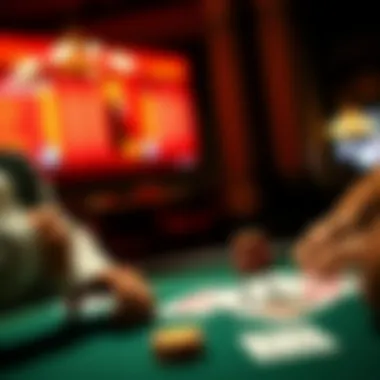Mastering Three Card Poker: Pair Plus Insights


Intro
Three Card Poker has carved out its niche as a staple in the gambling world. With its engaging gameplay and straightforward rules, it attracts not just seasoned gamblers but also newcomers trying their luck for the first time. One of the game's standout features is the Pair Plus payout mechanism, which can significantly enhance the excitement and the potential for winnings.
In this exploration of Three Card Poker, I will dive into the essential components of the game. We’ll unpack the mechanics behind Pair Plus, dissect various betting strategies, and offer insights that might give both novices and seasoned players a leg up in their gaming experience. Understanding the nuances of this game can elevate your play, turning a simple pastime into a potentially lucrative endeavor.
The world of Three Card Poker offers a wealth of options, and knowledge is critical to navigating these waters effectively. Sorting through the layers of rules, strategies, and payouts forms the backbone of this article, making it a valuable read for anyone looking to increase their understanding and improve their chances at the table.
Preamble to Three Card Poker
Three Card Poker stands among the most engaging casino games, melding the thrill of traditional poker with simplified mechanics. In this section, we will unearth the ropes of Three Card Poker, looking closely at its unique characteristics and the benefits it brings to both novice and experienced players. This game not only offers a swift gameplay experience but also emphasizes strategic betting through its Pair Plus mechanism.
Historical Context of the Game
Three Card Poker seems to have emerged in the 1990s, birthed from the minds of David Sklansky and John O’Neil. This game reworked familiar poker fundamentals into a brisk format, captivating players and finding a permanent spot in casinos across the globe. It diverged from its predecessors by reducing the number of cards and increasing the pace, making it more suitable for modern-day gaming experiences. Players quickly embraced it, appreciating its accessibility; at its heart, it's still poker, yet simplifies the strategy considerably. Its popularity spurred various adaptations, but the essence remains: fast, engaging, and rewarding.
Basic Rules and Gameplay Mechanics
At first glance, the rules of Three Card Poker may seem straightforward, but they encase layers of strategy just waiting to be unraveled. Each player is dealt three cards, and the aim is to create the best possible hand, pitting oneself directly against the dealer, rather than against other players.
- Ante Bet: Players begin by placing an ante wager.
- Dealing: Cards are dealt facedown to both players and the dealer.
- Decision Time: After viewing their cards, players have choices: they can either fold, conceding their ante, or make a "play" bet equal to their ante.
- Dealer’s Minimum: The dealer needs at least a Queen high to qualify.
If the dealer qualifies, hands are compared, and the best hand wins. The beauty of the game lies in the fact that beyond the standard outcomes, players can also partake in the Pair Plus wager. This side bet pays out based on the player's hand regardless of the dealer's cards, adding an extra layer of excitement.
Understanding Pair Plus Betting
Pair Plus betting is a captivating element within the framework of Three Card Poker. It offers players an alternative way to engage with the game, focusing on the strength of their hand rather than the outcome of a traditional game of poker. By understanding this betting modality, players can enhance their overall experience at the table, make more informed decisions, and potentially increase their winnings.
Engaging with Pair Plus comes with several advantages. First and foremost, it allows players to take a more proactive stance in the game. Unlike standard bets, which rely on comparing hands with the dealer, the Pair Plus wager is entirely based on the player’s cards. If luck smiles on you and your hand is strong enough, the rewards can be substantial. This factor alone makes Pair Plus an appealing choice.
However, not everything is a walk in the park. Players should be cognizant of the inherent risks. There’s a house edge that's traditionally higher on Pair Plus bets compared to standard play. Thus, while you can pocket larger payouts, the risk of losing your stake can also increase. Understanding how to balance risk and reward in this context is crucial to becoming a savvy player.
What is Pair Plus?
At its core, Pair Plus is a betting option that rewards players based solely on the strength of their own hand, without the need for a comparison against the dealer’s hand. The fundamental concept behind this bet is straightforward: players wager that they will be dealt at least a pair or better.
In practical terms, if a player places a Pair Plus bet, they can win payouts based on specific hand rankings even if their hand is inferior to the dealer’s. Expectedly, the payout structure reflects the rarity of these hand rankings. A simple pair may yield a modest payout, while a straight flush could result in a much more lucrative reward.
Furthermore, Pair Plus can be played independently from the main game. If a player’s feeling lucky, they can place this wager even without a strong understanding of Three Card Poker's strategies. This aspect makes Pair Plus highly attractive to novice players, yet also presents a tantalizing opportunity for seasoned gamblers seeking to boost their potential returns.
The Mechanics of Pair Plus Betting
Understanding the mechanics behind Pair Plus betting is vital for players who wish to navigate this side of Three Card Poker effectively. When placing a Pair Plus bet, players put down a specified wager before the cards are dealt. The dealer then distributes three cards to each player and three cards to themselves.
The next step follows with how payouts are determined according to the strength of the hand:
- Pair: Players receive a modest payoff.
- Flush: Higher than a simple pair, rewarding those fortunate enough to have all cards of the same suit.
- Straight: A combination of sequential cards, offering a better payout than a pair.
- Three of a Kind: A strong hand that commonly nets significantly higher payouts.
- Straight Flush: The rare occurrence of three consecutive cards all in the same suit yields a high reward.
Each of these hand rankings is assigned a specific payout multiplier, which can vary across casinos. This variability highlights the importance of understanding the house rules before settling down at the table.


Overall, mastering the intricacies of Pair Plus betting can empower players to elevate their Three Card Poker game. By combining strategic insight with an appreciation for the odds, players can enhance their gambling experience, possibly leading to more significant wins.
Payout Structure in Pair Plus
The payout structure of Pair Plus betting is pivotal to understanding Three Card Poker. It offers players a way to win by simply forming particular combinations of cards, independent of the dealer's hand. This feature is particularly appealing as it allows gamblers to engage with the game on multiple levels. Pair Plus is intriguing because it integrates strategy with the thrill of luck, thereby providing diverse paths to potential victory.
When players place a Pair Plus bet, they are putting their chips on the line, hoping to achieve a hand that ranks high enough to earn a desirable payout. But it's not just a matter of luck; knowing the payouts associated with different hands can critically impact gameplay decisions. Players need a firm grasp of the rewards that accompany various hand configurations, allowing them to adjust their strategies accordingly.
Moreover, the payout structure helps to define the risk-to-reward ratio of the Pair Plus wager, which varies significantly based on the hand ranking. It’s essential for both novice and seasoned players to understand how these payouts work to ensure they are making informed betting choices.
Comparison of Payouts for Hand Rankings
In Pair Plus, different hands correspond to different payouts, shaping the overall player experience. Here’s a breakdown of the notable hands and their features:
Flush
The flush is a hand made up of three cards of the same suit. Its distinct characteristic lies in its relative simplicity to achieve compared to others, making it a favored pick among players. A flush typically offers a more substantial payout than basic hands like a pair, reinforcing its popularity in the gameplay.
One notable feature of a flush is its versatility. Due to the less demanding requirement of needing just any three cards of the same suit, it is often seen as attainable, aiding in boosting players’ confidence. The downside, of course, is that while it pays better than many hands, it still falls short compared to straight flushes or higher-ranking combinations.
Straight
A straight includes three consecutive cards, regardless of their suits. The beauty of a straight lies in its requirement being less stringent than that of a flush. This hand balances risk and reward quite well, appealing to players who may want to play the odds without diving too deeply into complex strategies.
The unique feature about a straight is its inclusivity; it does not rely on suit priorities, making it easier for players to secure. However, while the payout can be satisfying, it doesn't compare to the flush in terms of commonality among winning hands, thus oscillating payout potential.
Three of a Kind
Three of a Kind is a robust hand type that consists of three cards of the same rank. Its main characteristic is the rarity of achieving it on such a short deal. This brings about a significant payout, adding excitement for players betting on it.
A unique aspect of this hand is that it often creates a sense of fervor at the table; when a player reveals their three of a kind, everyone takes notice. However, its rarity can also be a drawback, as players might have to wait longer for the right cards to fall into place, a fact to consider when weighing betting options.
Straight Flush
A straight flush combines the elements of both a straight and a flush—three consecutive cards of the same suit. This is undoubtedly one of the highest-ranked hands available in the game, as it requires precisely the right combination of cards.
The alluring feature of a straight flush is its rarity, making it a coveted hand. Its high payout potential makes it a focal point for many players aiming for a big win. However, achieving such a hand demands a keen understanding of card probabilities and a bit of luck, positioning it as a riskier option.
Mini Royal Flush
The mini royal flush is a unique variant of the royal flush, involving cards from a particular sequence that include the highest three values of the ace, king, and queen, all in one suit. Its exclusivity adds to its charm, commanding a particularly high payout.
One of the more thrilling aspects of this hand is its ability to surprise players with its sudden arrivals; it can turn a run-of-the-mill session into an exhilarating experience. However, if not well understood, players might overlook the strategic significance of betting on and holding for this specific hand, which could lead to missed opportunities.
Factors Influencing Payouts
Several elements can influence payouts in Pair Plus, extending beyond just the hand rankings themselves. For instance, side bets may vary in structure based on house rules or regional preferences, contributing to a player’s winnings. Additionally, the gaming establishment’s payout policies can play a significant role; some casinos might offer more favorable payouts for certain hands or promotions, while others stick to conventional rates. Understanding these nuances can be crucial for players hoping to maximize their winnings.
Strategies for Maximizing Pair Plus Wins
Maximizing your wins in Pair Plus requires a nuanced understanding of the game and an astute approach to betting. The emphasis on strategies for maximizing Pair Plus wins stems from the unique nature of this wagering option, where players are rewarded based on their hand ranking, independent of the underlying game play against the dealer. Harnessing the power of informed decisions can transform the experience from simply playing for fun to a more calculated engagement with potential returns.


Understanding Odds and Probabilities
A key element in improving your chances of winning lies in comprehending odds and probabilities. In Pair Plus, the payout largely depends on the strength of the hand you are dealt. Knowing the likelihood of receiving specific hands empowers players with the ability to make educated betting decisions. For example:
- Straight Flush: This is the rare gem of hands, appearing in approximately 0.2% of all instances, rewarding with potentially high payouts.
- Three of a Kind: A much more probable hand, showing up about 0.2% of the time, shows that not all three of a kind pay alike, often necessitating strategic betting decisions based on how often you expect to land such a hand.
- Flush: With roughly 3.2% odds, this hand also has a decent payoff but is easier to hit compared to others.
Understanding these statistics not only helps manage expectations but can influence when and how much to wager. For those adept at statistics, calculating expected values can significantly support betting strategy, allowing players to bet smartly.
When to Use Pair Plus Bets
Timing can be everything in the world of gambling. Knowing when to use Pair Plus bets can mean the difference between walking home empty-handed and cashing in on your bets. Generally, players should consider Pair Plus when:
- They feel confident about their hand based on historical performances. If you tend to find yourself receiving more high-ranking cards, upping your Pair Plus wager can be a savvy move.
- You’ve observed favorable games or patterns in your session. If your table has been generous with high-card hands just before you place your bet, it could be worth the risk to employ a Pair Plus bet.
- You’re willing to ride the waves of luck; gambling, after all, is inherently unpredictable! It's often a game of chance, but as they say: fortune favors the bold.
Incorporating Pair Plus into your strategy should make the experience much more enjoyable and possibly profitable. By twisting your understanding of odds with the timing of your bets, you can enhance not only your potential winnings but also the overall thrill of Three Card Poker.
Mathematical Models in Three Card Poker
Mathematical models play a pivotal role in understanding the dynamic nature of Three Card Poker. These models lay the groundwork on which players can base their strategies and decision-making, allowing them to navigate the game more effectively. By incorporating mathematical principles, players can analyze their probabilities of winning, thus arming themselves with crucial insights that can elevate their gameplay.
When discussing these models, one must consider how essential they are in calculating odds, understanding game structure, and formulating strategies. Knowledge of mathematics doesn’t just concern the cards in hand; it extends to the very fabric of chance itself that governs gameplay. Knowing when to bet, when to fold, and how to take calculated risks can be the difference between a rewarding or a disheartening gambling experience.
Probability Calculations for Different Hands
The crux of any mathematical model in Three Card Poker involves probability calculations tailored to specific hands, such as high cards, pairs, and straights. Understanding the likelihood of drawing these hands greatly influences your betting strategy and informs your gameplay decisions.
For example, let’s break down the probability of drawing a Three of a Kind:
- The odds of obtaining a Three of a Kind are approximately 0.24% from a standard 52-card deck.
- In contrast, the likelihood of pulling a pair is around 16.94%, showcasing that while pairs may occur more frequently, they don't pay as significantly compared to a Three of a Kind.
The key here is to recognize the patterns in hand rankings as they correlate with their probabilities—this can help tailor your expectations in terms of risk and reward during gameplay.
By recalibrating your strategy based on these probabilities, you can enhance your wager choices for the Pair Plus component, where even a minuscule edge can lead to notable payouts.
Expected Value of Pair Plus Bets
The expected value (EV) is a concept that every player should familiarize themselves with, particularly regarding Pair Plus bets. Calculating the expected value helps clarify whether a bet is worth the risk involved. Essentially, EV represents the average amount a player can expect to win or lose per bet if the same wager were placed repeatedly over time.
To ascertain the EV of a Pair Plus bet, the following formula can be employed:
EV = (Probability of Winning) x (Payout) - (Probability of Losing) x (Amount Bet)
Consider the example where you bet $10 on Pair Plus. If the odds of hitting a Straight Flush are 0.22%, with a payout of 40 to 1, the probability calculations of the payout against your stake become clearer, guiding your decision on whether that is a smart wager or if you’re better off sitting this hand out.
In a practical sense, the EV can vary greatly between poker tables, betting strategies, and personal risk tolerance. Choosing to bet or not should be a well-informed decision that weighs the potential rewards against the risks based on realistic understanding of mathematical models and your personal playing style. This balanced approach to betting will support a more informed, and ultimately more lucrative, gaming experience.
House Edge Considerations
Understanding the house edge is crucial when diving into Three Card Poker and, specifically, the Pair Plus payout system. The house edge represents the percentage of each bet that the casino expects to keep over time. For players, being informed about this aspect can shape their betting strategies and ultimately impact their chances of coming out ahead.
In the context of Three Card Poker, the house edge varies depending on the type of bet players make. This margin can influence choices regarding which bets to place and how much to wager. With Pair Plus bets, for instance, the house edge can hover around 2.32%, significantly lower than many other table games. Therefore, understanding these odds can lead to more informed decisions and better chances of winning.
Understanding the House Edge


The house edge is, in plain terms, a built-in advantage that casinos incorporate into their games. It ensures that the house does profit from the bets players make. In Three Card Poker, the edge is not uniform across the board. For the Pair Plus bet, which pays based on the hand strength, this edge can be affected by the specific payouts offered by the casino.
Players placing a Pair Plus bet will notice that the payouts for various hand rankings also influence the house’s edge. If you find a table that offers higher payouts for certain winning hands, the effective house edge might be less daunting. Understanding this concept can lead to smarter gambling choices. Players benefit by seeking those games that offer more favorable payout structures, as these can lessen the casino's long-term advantage.
"A player who understands the house edge is like a sailor who knows the winds – better prepared to navigate the stormy seas of gambling."
Comparative Analysis with Other Poker Variants
When comparing the house edge of Three Card Poker with other poker variants, the differences can be striking. Many players may have experience with games like Texas Hold'em or Omaha, where the dynamics shift significantly due to the number of community cards and player interactions.
In typical tournaments of Texas Hold'em, the house edge can often range around 5%, primarily due to the number of players competing against each other rather than against the casino itself. Conversely, games like Pai Gow Poker have a house edge nearing 2.5%, creating a closer race with the Pair Plus bet in Three Card Poker.
The unique thing about comparing these games lies in how they engage players' skills. While Three Card Poker can be largely seen as a game of chance, players have the tools to reduce the house’s advantage by leveraging better strategies or understanding payout structures. This is not always the case in other variants, where player skill can heavily influence outcomes.
Practical Tips for New Players
When venturing into the world of Three Card Poker and especially engaging with the Pair Plus betting option, it’s essential for newcomers to equip themselves with practical knowledge. Understanding the nature of the game is not just about snazzy moves and flashy wins; it’s about making informed decisions that can either bolster your bankroll or lighten your wallet. This section aims to shed light on two critical aspects: choosing the right table and establishing a sensible budget for your gameplay.
Choosing the Right Table
Selecting the right table can often feel like finding a needle in a haystack. A table is not merely a surface to play on; it's the cradle of your gaming experience. Here are some elements that can help steer your choice:
- Table Limits: Look for tables that accommodate your financial comfort zone. If you find yourself sitting at a table with limits too high for your bankroll, it might lead to panic bets or hasty decisions. On the flip side, tables with stratospheric limits may attract players who are more skilled and aggressive. Gauge the table's minimum and maximum limits before sitting down.
- Crowd Composition: Observe the players at the table. If you notice a mix of new faces and experienced players, that could be a good balance to learn from. When you're surrounded by seasoned players, they may take more risks, which can change the dynamics of the game. It might not be the best learning environment, especially at the beginning.
- Seating Position: The position you take at the table can impact your strategy. If you’re sitting close to the dealer, you might have a better view of the game's flow. Moreover, consider if the table allows you to play your own game. If you find yourself constantly caught in the crossfire of aggressive players, it may be worth moving to a quieter table where you can think clearly.
Ultimately, choosing the right table can set the stage for better gameplay and less stress. Knowing where to sit can mean the difference between a rewarding experience and one filled with unnecessary anxiety.
Establishing a Budget
When it comes to gambling, establishing a budget is akin to leaving home with a full tank of gas. You wouldn't start a road trip without a clear idea of your fuel capacity, so why enter a casino without a defined budget? Here’s how to do it:
- Determine Your Budget: Before you even think of placing a bet, decide how much money you can afford to lose. It’s crucial to differentiate between entertainment costs and essential expenses. Whatever amount you choose, stick to it—your bank account will thank you later.
- Break It Down: Once you have your total budget, consider breaking it down into smaller amounts for each gaming session. If your overall budget is, let’s say, $200, you might decide to play with $50 during each session. This segmentation helps in managing your funds and allows for multiple opportunities to play without blowing your entire budget in one go.
- Use a Betting Strategy: Some players prefer betting a certain percentage of their budget per hand. This is a systematic way of prolonging your playtime and gives your bankroll the opportunity to grow if fortune smiles upon you.
- Avoid Chasing Losses: It’s easy to fall into the trap of trying to win back lost money by increasing your bets. This leads to hasty decisions and usually ends in further losses. Stick to your budget and play your game; remember, it's about the enjoyment of play too.
To sum up, appropriate budgeting ensures that your gaming experience remains enjoyable and reduces anxiety associated with financial losses. As the saying goes, "It’s not about how much you win or lose, but how you manage the game."
"Good gambling habits can lead to a more pleasant experience and perhaps even a bit more luck on your side."
By taking careful steps to choose the right table and establishing a solid budget, new players lay the foundation for a more fruitful and enjoyable experience in the captivating world of Three Card Poker.
End
In wrapping up our exploration of Three Card Poker and the impactful Pair Plus payout mechanism, it’s essential to recognize the various layers that make this game appealing to both novice and seasoned gamblers. The depth of understanding about game mechanics, coupled with the significant payout structure, enhances the overall gaming experience significantly.
Recap of Key Insights
Reflecting on our journey, several critical points stand out:
- Understanding the Game Mechanics: Familiarity with the rules and gameplay helps players make informed choices, decreasing the learning curve.
- Pair Plus Betting: Recognizing this optional aspect allows for a more strategic approach. Players can potentially increase their winnings based purely on the strength of their hand without needing a qualifying hand.
- Payout Structure: Grasping how different hand rankings influence payouts can directly affect betting strategies. A hand as simple as a Flush can pay differently, demanding that players comprehend their potential for earnings thoroughly.
- House Edge and Comparisons: Evaluating the house edge keeps players aware of their odds compared to other poker variations. This consideration can empower gamblers to find favorable games.
- Maximizing Wins: Through understanding betting odds and utilizing strategies effectively, players increase their chance of winning, thereby making their experience fruitful.
Encouragement for Continued Learning
As we've seen, the journey of mastering Three Card Poker and the complexities of the Pair Plus mechanism is just beginning. Continuous learning is vital in the gambling landscape, where strategies and odds evolve constantly. I urge players not to shy away from honing their skills or seeking additional knowledge.
Consider exploring online forums like Reddit and sites such as Wikipedia for updated strategies and insights. Engaging with the poker community helps to gain fresh perspectives. Ultimately, intelligent gamblers will find success through learning, practice, and keeping a finger on the pulse of the game’s dynamics.
"Knowledge is power, it can turn the odds in your favor in Three Card Poker."
With each session at the table, take the lessons learned here and probe deeper into strategies, odds, and gameplay approaches. The stakes can be high, but with knowledge and a sound strategy, the potential for rewarding experiences and financial gains is considerable.



